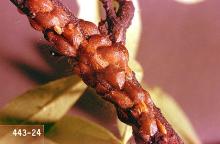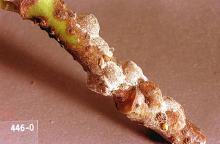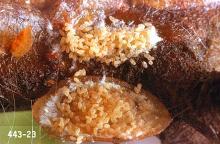Parthenolecanium corni
Pest description and crop damage This scale assumes many sizes, shapes, and colors. The typical form is almost hemispherical, shiny brown, smooth, and approximately 0.12 to 0.19 inch in length. Eggs are oval and pearly white. The young vary from yellow to pale brown.
Biology and life history Adult females may be found on leaves or bunches but mostly on shoots of current growth or on 1- to 3-year-old wood. Males have not been observed. Females lay eggs under their bodies. As the female dies, the body shrinks and an egg-filled pocket is formed. As more eggs are laid, the walls of the scale's body hardens and, after death, brittle. Young overwinter in a juvenile state on 1- to 3-year-old wood. They mature in late spring when eggs are produced in great abundance. Hatching continues during early to midsummer. There is one brood per year.
Management-biological control
Although biological controls of European fruit lecanium scale have not been studied, parasitic wasps generally parasitize scale insects heavily. In the Yakima Valley, Metaphycus spp. is the dominant parasitoid.
Management-cultural control
Since much of the vine is removed at pruning, it may be unnecessary to apply control measures unless the scale is infesting the main framework of the vine (main canes, cordons and trunk).
Management-chemical control: HOME USE
Dormant-season spray
- horticultural oils-Some formulations OMRI-listed for organic use.
Growing-season spray
- cyfluthrin
- carbaryl-To avoid harming bees, do not apply products containing carbaryl to plants in bloom.
- imidacloprid
- zeta-cypermethrin
Management-chemical control: COMMERCIAL USE
- horticultural oil (several brands)-Consult label for rate. Scales are controlled best in the dormant season. Apply spray at 200 to 300 gal/A with a hand or air carrier machine. Sprays help control mealybugs. Do not apply dormant oil after buds start to open. Some formulations OMRI-listed for organic use.
- imidacloprid (Admire Pro and other brands)
- Soil application at 0.25 to 0.5 lb ai/A. PHI 30 days. Apply in one or two drip irrigations between budbreak and pea size stage of berry development. Consult label for restrictions. Do not apply more than 0.5 lb ai/A per year. Group 4A insecticide.
- spirotetramat (Movento) at 0.10 to 0.13 lb ai/A. PHI 7 days. Ensure that there is adequate foliage for absorption of the compound. Allow 30 days between applications. Do not exceed 0.2 lb ai/A per season. Use a penetrating adjuvant to ensure efficacy on foliage; see label for details on which adjuvants to use or avoid. Suppresses, but does not control. Group 23 insecticide.




